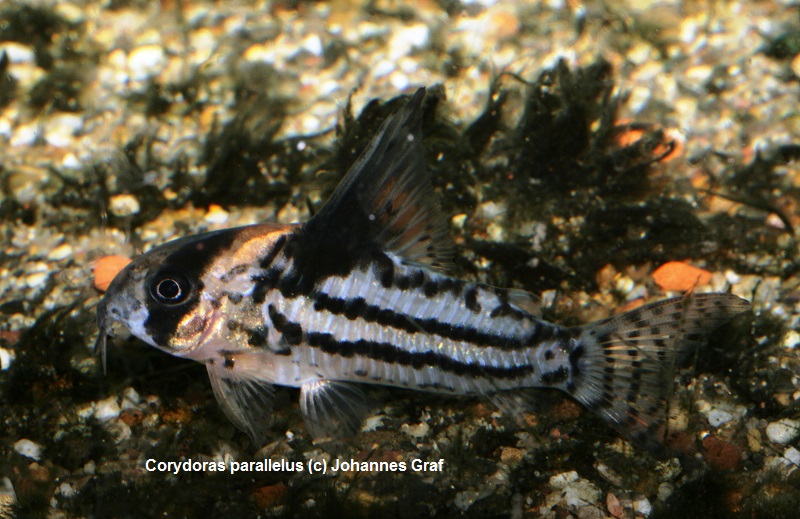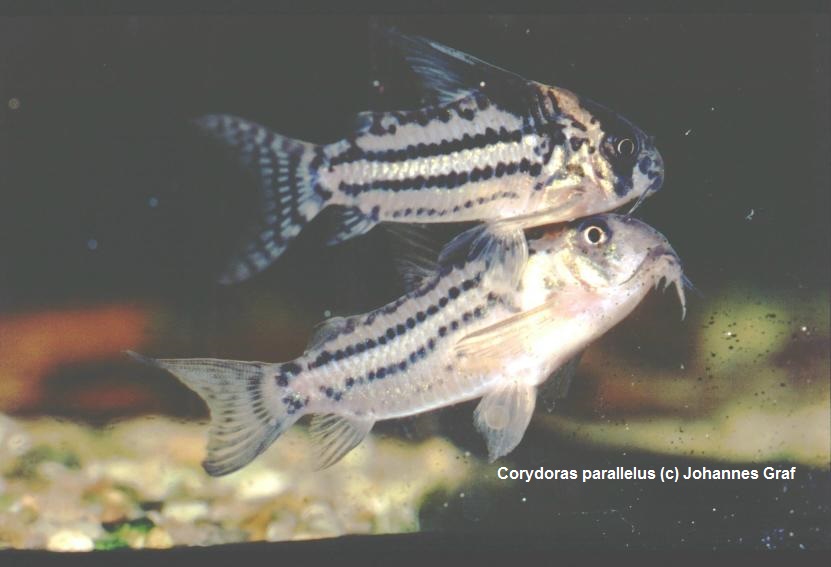|
Welcome at
Johannes Graf´s Corydoras pages

A friendly face in the aquarium - Corydoras species are very popular, as well as their relatives Aspidoras and Scleromystax.
Some species, like Corydoras aeneus in
various forms, Corydoras paleatus und others are part of the standard
offers in petstores. This is not in my focus. Since nearly 20 years I
put my eye on the keeping and breeding of special and rare Corydoras
species.
All the species of the genus Corydoras-Arten originate in southern
America, living in a wide variety of biotopes. They all have in common
the reduced swimming bladder that makes them to bottom dwellers (except
C. pygmaeus) searching for food with the help of their barbels.
Petstores use to sell Corys to beginner aquarists
when buying a complete set of fishes as a vacuum cleaner for the
gravel. They say that Corys live on the food rests of the other fishes.
This is totally wrong. Corys have a pretty high demand on the quality
of their food. if there are fast, hungry other fishes in the aquarium,
Corys will suffer without extra food targeted to them.
Some basic rules for purchase and keeping:
- Buy only healthy fishes. Otherwise already the
start is bad. Watch for abnorm body shape, damaged fins, fungus etc.
the fishes should be lively and trying to escape from the net.
- Inform yourself PRIOR to purchase on the adult
size, preferred temperature, and necessary water parameters. Corys live
all over South America and there are differences.
- Don´t overcrowd, but also don´t
keep single specimen. Corys live in groups. 6 fish should be the
minimum, the upper limit sets the size of the aquarium. An aquarium of
80 cm or 1 m is good for the beginning. A larger aquarium is way easier
to maintain than a small one.
- Weekly waterchanges of 1/3. Nearly all of the
species originate from rivers with continuous water running through
(except in the dry season, see "breeding").
- Hiding places, like a root or something where
they can hide and rest. A patch of dense plants will do as well. Eine
offene Sandfläche zum
Gründeln. Hier sollte auch das Futter platziert werden.
- Feed enough, but not too much. Corys eat
quality granulates, but the like more the good stuff like frozen
mosquito larvae, Artemia, Tubifex. They like everything that looks like
a worm, like Tubifex, Enchytraeus, Grindal worms. But all those
foodstuffs are very nutritious and should be given in large amounts
only in the breeding season.
- Water parameters of pH 6,5 to 7,5 und
hardness up to 170 ppm are OK. Basically Corys are soft-water-fishes.

Panzerwelse
züchten
Sometimes it happens that a Cory species
considered to be difficult to breed spontanously spawns to the glass of
a community tank. Most time spawning activities are induced by a water
change. it can be noticed by hectical activity and swimming up and down
the glass. The male takes a position across the front of the female
(called T-position) and after that the female carries one or more eggs
in the bag-like folded pectoral fins. the process teerminates in the
deposition of the eggs under plant leaves, at the glass or other
surfaces. Most times the places are well-served from the water
current.
So far is the theory. If you want to induce the
Corys for spawning on purpose, there is a bit more to do. At home, two
climate phases influence the biotope of our Corys: dry season and wet
season.
In the dry season even in the tropical rainforest
most smaller creeks and rivers dry out completely. Big rivers get
very much smaller. At Tefe (Brazil) the level difference is 11 meters!
Most of the land is dry. All the fishes, who don´t make it to a
larger water, simply die. This is an absolutely normal process that
happens every year for example with millions of Red Neon
(Paracheirodon axelrodi). Therefore, sustainable collection from the
wild stocks for export are no problem at all. The same holds for our
Corys. There are always enough to survive the dry season in rest water
ponds, where they stay at very high temperatures, high predatory
pressure and really bad water parameters.
When the rainy season starts, this is the time for
our Corys. Released from the rest water ponds, they spread ouf in the
flooded land eat masses of food (insect larvae) and the females set up
eggs. Stimulated by the cool fresh water, spawning begins. The larvae
hatch from the eggs, they have plenty of food - the cycle starts
again.
The better the breeder simulates this cycle, the better will be the
breeding results. That is: in summer (dry season) less waterchanges,
low water level, little food, high temperature, in winter (rainy
season): maasive waterchanges high water level. lots of food and lower
temperatures.
After eggs being laid and being fertile (a problem in some species),
eggs can be collected with the fingers and put in small containers (eg
ice cream boxes) to hatch. Larvae feed on their yolc sac for some days
(specific for the species). Only after the yolc sac is resorbed, they
can eat. Best starting food are microworms (Panagrellus redivivus).
After having eaten in the container several times, the fry can be
trasferred in a raising tank. |